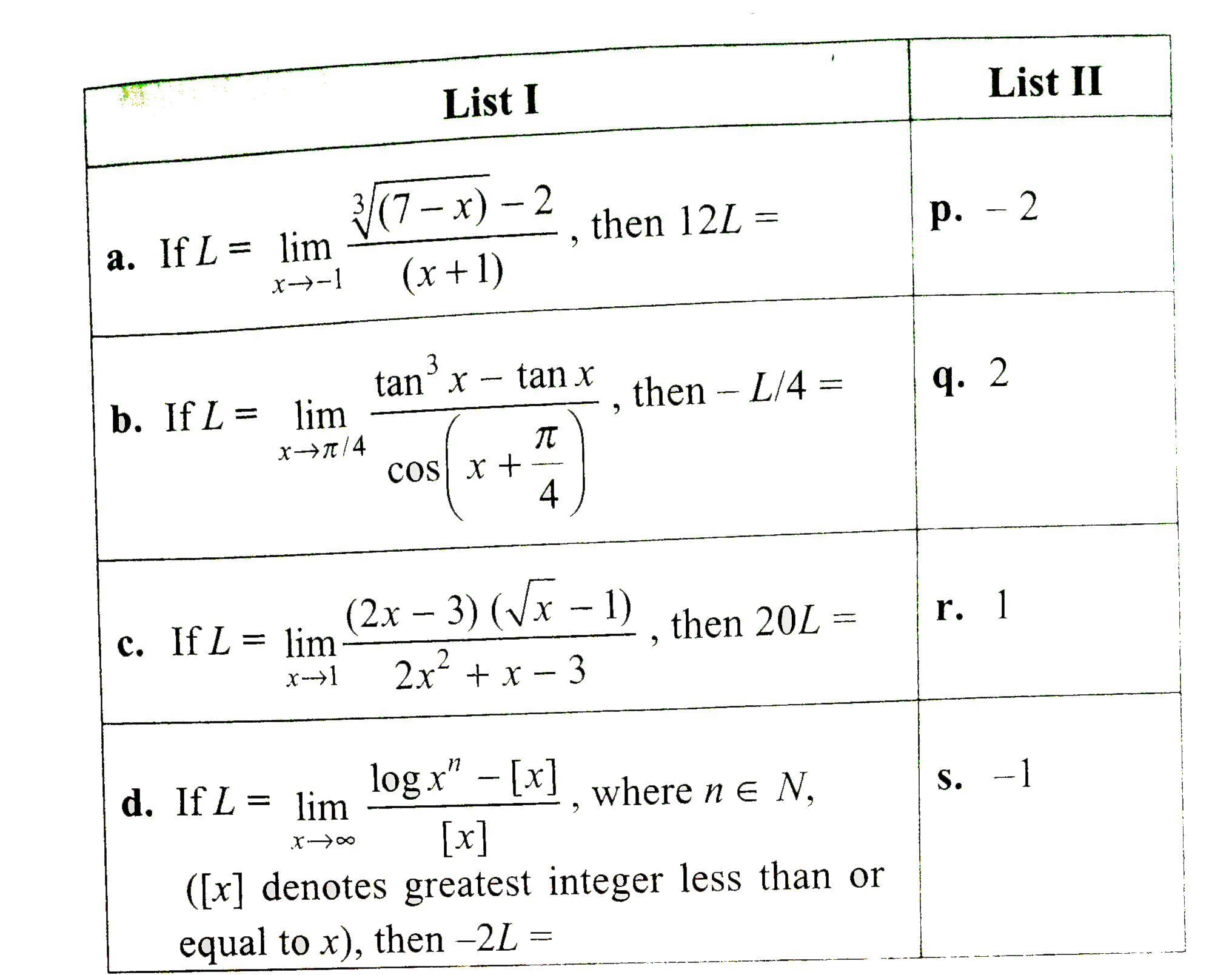Let
Also, .Solution in Bengali
The correct Answer is:C
Using L'Hospital's rule
Dividing by and taking limit, we get
or
Topper's Solved these Questions
- LIMITSBook:CENGAGE PUBLICATIONChapter:LIMITSExercise:Matrix Match Type
Explore 5 Videos
- LIMITSBook:CENGAGE PUBLICATIONChapter:LIMITSExercise:Numerical Value Type
Explore 26 Videos
- LIMITSBook:CENGAGE PUBLICATIONChapter:LIMITSExercise:Exercises (Single Correct Answer Type)
Explore 76 Videos
- JEE 2019Book:CENGAGE PUBLICATIONChapter:JEE 2019Exercise:Chapter 10
Explore 8 Videos
- LINEAR COMBINATION OF VECTORS, DEPENDENT AND INDEPENDENT VECTORSBook:CENGAGE PUBLICATIONChapter:LINEAR COMBINATION OF VECTORS, DEPENDENT AND INDEPENDENT VECTORSExercise:DPP 1.2
Explore 10 Videos
Similar Questions
Match the following lists:

View SolutionThe reciprocal of the value of: limn→∞(1−122)(1−132)(1−142)(1−1n2)is
View Solutionlimx→0[sin(sgn(x))(sgn(x))], where [.] denotes the greatest integer function, is equal to
View SolutionIf y = y(x) is the solution of the differential equation, xdydx+2y=x2 satisfying y(1) = 1, then y(12) is equal to
View SolutionThe number of integral values of p for which (p+1)ˆi−3ˆj+pˆk,pˆi+(p+1)ˆj−3ˆk and −3ˆi+pˆj+(p+1)ˆk are linearly dependent vectors is q
View SolutionIf n is a natural number such that n=P_(1)^(a_(1))P_(2)^(a_(2))P_(3)^(a_(3))...P_(k)^(a_(k)) where p_(1),p_(2),...p_(k) are distinct primes then minimum value of ln n is:
View Solutionif (1+x)^(n)=p_(0)+p_(1)x+p_(2)x^(2)+--+p_(n)x^(n) the value of p_(1)-p_(3)+p_(5)+...
View SolutionLet a_(1) p_(2)>...p_(n)>0 such that p_(1)+p_(2)+p_(3)+p_(n)=1. Also F(x)=(p_(1)a_(1)^(x)+p_(2)a_(2)^(x)+...+p_(n)an^(x))^((1)/(z)) Compute
View SolutionIf (1+x)^(n)=p_(0)+p_(1)x+p_(2)x^(2)+....+p_(n)x^(n) then (p_(0)-p_(2)+p_(4)-p_(6)+....)/(p_(1)-p_(3)+p_(5)-p_(7)+......)=
View SolutionLet p_(1),p_(2),...,p_(n) and x be distinct real number such that (sum_(r=1)^(n-1)p_(r)^(2))x^(2)+2(sum_(r=1)^(n-1)p_(r)p_(r+1))x+sum_(r=2)^(n)p_(r)^(2)<=0 then p_(1),p_(2),...,p_(n) are in G.P.and when Statement 2: If (p_(2))/(p_(1))=(p_(3))/(p_(2))=...=(p_(n))/(p_(n-1)), then p_(1),p_(2),...,p_(n) are in G.P.
View SolutionLeta1>a2>a3>...>an>1.
p1>p2>p3>...>pn>0 such that p1+p2+p3+...+pn=1.
Also, F(x)=(p1ax1+pnaxn)1/x.
limx→∞F(x) equals
View SolutionProve that 1+1⋅1P1+2⋅2P2+3⋅3P3+…+n⋅nPn=n+1Pn+1.
View Solutionसाबित कीजिए की
1P1+2⋅2P2+3⋅3P3+...+n⋅nPn=n+1Pn+1−1 .
View SolutionThe value of nP1+nP22!+nP33!+......+nPnn!
View Solutionif p1 and p2 are odd prime numbers such that p1>p2 then P21−P22 is always
View Solution(1+x)n=p0+p1x+p2x2+…+pnxn , then p0+p3+p6+….. =
View Solution